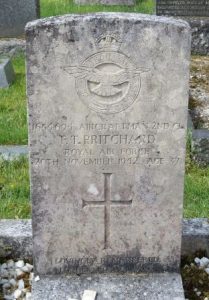Newbridge-on-Wye is a village situated in the ancient county of Radnorshire, located roughly in the middle of Wales, and lies some seven miles south of Rhayader, along the A470 main road. The village was originally on the drover’s trail, and is situated at a crossing over the River Wye. The men of the village who fell during both World Wars are commemorated on two identically named war memorials, one in All Souls Church, and the other in the Baptist Church.
The Great War, 1914-1918
Frank Bryant, Sergeant, 14088, South African Infantry. Frank was born in Stoke Coury, Somerset in 1874, the son of Henry and Elizabeth Bryant. His mother died in 1877 and his father moved the family to Porthllwyd Farm, Newbridge-on-Wye. Frank had married Alice Bryant at some time prior to the war and was living in South Africa when war erupted. He enlisted into the 2nd Regiment, South African Infantry, which formed part of the newly raised 1st South African Infantry Brigade. The Brigade embarked from Cape Town for Egypt, and took part in the fighting against the Senussi tribesmen. In the Spring of 1916, the South Africans sailed for France, and joined the 9th (Scottish) Division. The Division saw heavy fighting on the Somme, especially at Delville Wood, that summer, and in April 1917 took part in the First Battle of the Scarpe and the Third Battle of the Scarpe. The Division moved north to Ypres, and fought at the Battle of the Menin Road, and at the First Battle of Passchendaele, before being moved to Cambrai, and fighting at the Action of Welsh Ridge. In March 1918 the division was still in the Cambrai area, and was one of the Divisions hit there by the German Spring Offensive of 21 March 1918, suffering terrible casualties before being moved to Flanders to rebuild, but the Germans launched another offensive there during April 1918, and the Division again became caught up in desperate fighting. After the German offensive petered out, the Allies took the offensive from 21 August 1918, launching a general offensive along the Western Front, and the 9th Division moved to the Somme sector in September to take part in the offensive, reaching Corbie by 29 September. By 5 October the South African Brigade had reached Ronssoy, and on the following day received their orders, to take part in a general advance in two days’ time. At dawn on 8 October 1918, the South Africans launched their attack and reached the first objective, the Red Line, at La Sablonniere by 07.00. The next objective, the town of Serain and the Usigny Ravine, was captured with the aid of a tank. Frank was killed at some time during the fighting that day. The 44-year-old is buried in Beaurevoir British Cemetery, France. His widow, Alice, returned to Britain, and lived at Paroikia, 155, Beauchamp Road, Upper Norwood, London.
Joseph Sidney Champ, Sergeant, 268270, South Wales Borderers. Joseph was the son of Thomas and Thurza Champ, of Red Barn Farm, Wolvercote, Oxford. He came to Newbridge-on-Wye to work as a Footman prior to the war. Joseph enlisted into the King’s Shropshire Light Infantry at Hereford on 18 August 1914 and was posted to the Depot Battalion for training. Joseph was then posted to the 5th Battalion, King’s Shropshire Light Infantry, which was attached to 42 Brigade, 14th (Light) Division, and landed in France with the battalion on 21 May 1915. The Division was to see its first action during the Action of Hooge, where it was the first unit to be attacked by the German use of flamethrowers. It then fought at the Second attack on Bellewaarde. Joseph was wounded at some time, and returned to England, joining the 3rd Battalion, KSLI by 19 September 1916. On 23 November he transferred to the Herefordshire Regiment and then on 16 July 1917 transferred to the 2/2nd Battalion, Monmouthshire Regiment. On 19 September Joseph embarked for France again, and was posted from the Infantry Base Depot to the 12th Battalion, South Wales Borderers on 25 September 1917. The battalion was attached to 119 Brigade, 40th (Bantam) Division. Joseph joined the battalion in the Cambrai sector, and took part in the Divisions famous assault on Bourlon Wood on 23 November. The Division remained in the area over the coming months, but on 10 February 1918, the 12th SWB was disbanded and Joseph was posted to the 9th Entrenching Battalion. On 23 April 1918 Joseph was transferred to the 2nd Battalion, South Wales Borderers, which was attached to 87 Brigade, 29th Division. The Division saw further fighting during the defence of Outtersteene, before the fighting died away, then took part in the Advance in Flanders later that year, advancing from the Gheluvelt area. On 11 September the 2nd SWB was in trenches at Ledeghem, and suffered several days of artillery fire, mixed with gas shell, before launching an attack on 15 October 1918. Joseph was killed in action during the fighting that day. The 23-year-old is buried in Dadizeele New British Cemetery, Belgium.
Horace Davenport, Private, 300539, The King’s (Liverpool Regiment). Horace was born in Ludlow in 1885, the son of Henry James Davenport and Elizabeth Davenport (nee Coates). By 1901 the family was residing at 2, Church House, Newbridge-on-Wye. Horace enlisted into the 1/1st Battalion, Lancashire Hussars Yeomanry soon after the outbreak of war and married Mary Jones in Wiltshire on 3 July 1915, whilst stationed on Salisbury Plain. Horace was serving in France with one of the Squadrons of the Lancashire Hussars when the Squadron was merged into the 18th Battalion, King’s (Liverpool Regiment) at Torreken Farm, Ypres on 24 September 1917. The battalion was attached to 21 Brigade, 30th Division, and was taking part in the Third Battle of Ypres. By the beginning of January 1918, the Division was in reserve, at Gheluvelt, and began to move to the Somme sector by 12 January, before taking over a section of the line in the St. Quentin sector, at Fluquieres. At dawn on the morning of 21 March 1918 the Germans launched their Spring Offensive, along the section of front running from Croisilles, south to La Fère. The 30th Division was hit hard, seeing terrible fighting over the coming days as it was forced to withdraw past Manchester Hill. The situation was understandably chaotic, and Horace was posted as missing, believed killed in action on 21 March 1918, but he was later adjudged to have been killed in action on 28 March 1918, aged 32. Horace has no known grave and is commemorated on the Pozieres Memorial, France.

Benjamin David Davies, Private, 38468, Gloucestershire Regiment. Benjamin was born on 20 August 1898, the son of David and Annie Davies, of 3, Gwarfordd, Newbridge-on-Wye. He enlisted at Cardiff into the South Wales Borderers, and after completing his training was posted to France, joining the 8th Battalion, Gloucestershire Regiment, which was attached to 57 Brigade, 19th (Western) Division. He most probably joined the battalion at Ypres, following the Divisions actions during the Battle of Messines Ridge in June 1917. After a brief rest, where the Division rebuilt its strength, it then took part in the main Passchendaele offensive, which was launched on 31 July 1917. By October the Division had moved to the Merris area, and carried out several weeks of training whilst rebuilding, before moving south in the first week of December, taking over a section of the front line in the Ribecourt Sector. The Division wintered here, holding this sector over the coming months. At dawn on 21 March 1918 the Division was hit hard by the opening assault of the German Spring offensive, Operation Michael, and suffered terrible casualties during a fighting withdrawal over the coming days. The battered Division was relieved by the Australians, before being sent to the quieter Messines sector again on 30 March, to rest and rebuild. Unfortunately, the second phase of the German offensive, Operation Georgette, was launched along the Lys valley on 9 April, and the Division once more became embroiled in desperate fighting. Benjamin was wounded at some time during the coming days, and was evacuated to Hospital in Rouen, where he died of his wounds on 27 April 1918, aged 19. He is buried in St. Sever Cemetery Extension, Rouen, France.
Evan Thomas Davies, Private, 51663, Cheshire Regiment. Evan was born at Faldlace Farm, Llanyre in 1891, the son of Evan and Sarah Jane Davies. He worked as a waggoner for David Mills at Newbridge-on-Wye prior to the war and enlisted at Knighton into the King’s Shropshire Light Infantry on 31 May 1917. He was posted to Pembroke Dock for training with the 3rd Battalion, KSLI and after training embarked at Southampton for France on 19 October 1917. Upon arrival in France he briefly joined the 5th Battalion, KSLI, but within days was transferred to the 15th Battalion, Cheshire Regiment. The battalion was attached to 105 Brigade, 35th Division, and was at Ypres, taking part in the Battle of Passchendaele. By the spring of 1918 the division was back on the Somme, and fought at the First Battle of Bapaume, during the German Offensive, and took part in a fighting withdrawal to Bouzincourt, where it was relieved by the 38th (Welsh) Division. The division remained in the area over the coming weeks, and after a spell in reserve moved back into the front to the left of the 38th Division. Evan was badly wounded in the thigh during an assault on Aveluy Wood on 1 June 1918. He was evacuated to the 107th Field Ambulance before being sent to the Base Hospital at Le Treport where he died of his wounds on 5 June 1918, aged 26. Evan is buried in Mont Huon Military Cemetery, Le Treport, France. He is also commemorated on the Llanyre and Nantmel War Memorials.
John Lloyd Davies, Private, 56967, Welsh Regiment. John was the son of Evan Davies, of Belle Vue, Llanfihangel, Garth. He enlisted into the 3/1st Battalion, Montgomeryshire Yeomanry at Rhayader on 19 July 1915, and was posted to Park Hall, Oswestry for training. On 8 August 1916 John embarked for France, and was transferred to the 10th Battalion, Welsh Regiment, which was attached to 114 Brigade, 38th (Welsh) Division, joining the battalion in camp at Poperinghe on 1 September. The Division was rebuilding, following its ordeals during the attack on Mametz Wood in July, and had been allocated the task of holding the Canal Bank sector of the front line, north of Ypres. The 10th Welsh began life in the Ypres Salient assisting the 177th Tunnelling Company, Royal Engineers, which had been constructing deep dugouts at Birr Cross Roads, and mining in the Railway Wood sector. The 177th TC had sent men to the Canal Bank sector, to aid in the construction of dugouts and bunkers, and the 10th Welsh, comprised mainly of South Wales miners, was the ideal unit to help in this work. The war diary for the time states the ground was of ‘bastard blue clay’, so digging conditions must have been hard. This work continued for many weeks, until the 10th Welsh moved into the front line on 17 January 1917, to begin a routine tour of duty. These tours usually comprised four days in support, four in the front line, four in reserve, on a rolling basis, as well as supplying working parties and carrying out routine trench raids and patrols. On 24 March 1917 the 10th Welsh was in the process of being relieved by the 13th Welsh after another tour in the front line, when John was wounded, suffering gunshot wounds in the back and right knee. He was evacuated to the 46th Casualty Clearing Station at Proven, where he died of his wounds on 28 March 1917, aged 23. John is buried in Mendinghem Military Cemetery, Belgium.
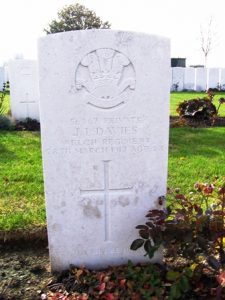
Pryce Thomas Davies, Company Sergeant Major, 320532, Welsh Regiment. Pryce was born at Newbridge-on-Wye in 1889, the son of John and Mary Jane Davies. His parents must have died soon afterwards, and Pryce was raised by another family at Newbridge, before being sent to Gigrin Hut Workhouse as a young boy. Pryce then made his way to Swansea to find work as a collier and married Mary Beatrice Jones, of Cillenon Farm, Three Crosses, Dunvant, Swansea in 1914. Pryce was already serving with the Glamorgan Yeomanry, a Territorial unit, when war broke out. The Glamorgan Yeomanry mobilised for war, moving to Tenby to join the South Wales Mounted Brigade, then moved to Hereford, before the South Wales Mounted Brigade moved to locations in Norfolk, joining the 1st Mounted Division. In March 1916 the Division sailed for Egypt, where it took part in the campaign against the Senussi tribesmen, as well as guarding the Suez Canal against the Turks. On 2 February 1917 the Glamorgan Yeomanry merged with the Pembroke Yeomanry to form the 24th (Pembroke & Glamorgan Yeomanry) Battalion, Welsh Regiment. The battalion was attached to 231 Brigade, 74th (Yeomanry) Division, which had just formed, joining the EEF, and saw its first major action during the Second Battle of Gaza on 17 April 1917. The battle was a failure, and the commander of the EEF was replaced by Sir Edmund Allenby, who re-organised his forces before launching a Third assault on Gaza on 1 November 1917, along a wider front running from Gaza to Beersheba. This time the EEF broke the Turkish line, and began to advance on Jerusalem. Pryce was killed in action when the 24th Welsh were sent to support an assault on the Wadi Shebab on 1 December 1917. The 28-year-old is buried in Jerusalem War Cemetery, Israel. Pryce is not commemorated on the Newbridge-on-Wye memorial, but is named on the Swansea Cenotaph.
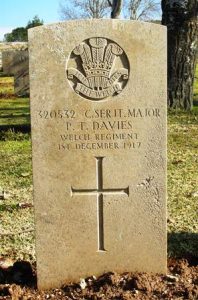
David Thomas Edwards, Private, 97581, Machine Gun Corps. David was the son of Daniel Jones Edwards and Sarah Jane Edwards, of Lower Shop, Newbridge-On-Wye. He worked as a Butcher prior to the war. David enlisted into the 4th Battalion, King’s Shropshire Light Infantry at Knighton on 26 January 1917 and was posted to the Barracks at Shrewsbury for training. On 19 June 1917 David embarked for France at Folkestone, and joined the Machine Gun Corps Base Depot at Camiers. He was initially posted to the 97th Company, Machine Gun Corps, which was attached to the 32nd Division. David was shot in the knee on 3 December 1917 and evacuated via the 91st Field Ambulance to the 46th Casualty Clearing Station before being sent to the 25th General Hospital at Étaples for treatment. By 28 March 1918 he had recovered enough to join the MGC Base Depot again, and was posted to the recently formed 32nd Battalion, Machine Gun Corps on 4 April. The battalion had been formed by the merger of the Machine Gun Companies in the 32nd Division. David fought with the Division during the great offensive from 21 August 1918 onwards, and survived the war. He was discharged, Class B, on 25 January 1919, to resume civil employment in Newbridge-on-Wye. Sadly, his health had suffered as a result of his service, and he died of gastritis on 16 February 1921, aged 35. David is buried in St. Bride’s Churchyard, Llansanffraid Cwmteuddwr. David is not commemorated by the CWGC, and is not named on the Newbridge-on-Wye war memorial.
John William Edward Rice Evans, Lance Corporal, 65356, Machine Gun Corps. John was the son of Joseph and Margaret Evans, of Upper Llwyn, Newbridge-on-Wye. He worked as a Butcher at Pontardawe prior to the war. John enlisted at Fleur-de-Lys into the Welsh Regiment, and during his training became a specialised machine-gunner, before being posted to the 38th Battalion, Machine Gun Corps, which was attached to the 38th (Welsh) Division. He probably joined the battalion around the time of its formation on 2 March 1918, just prior to the Divisions move south to the Somme sector, where it replaced the battered 2nd and 47th Divisions in the line facing Bouzincourt Ridge. The Division launched an attack against the Germans holding the ridge soon after arrival, taking over the high ground, and in front of them lay the Ancre Valley, and Thiepval Ridge. Several minor offensives took place over the coming month, then on 21 August 1918 the Division fought its way across the Ancre Valley, taking the heights of Thiepval Ridge and Pozieres Ridge, before beginning its advance towards the Hindenburg Line, as part of a great Allied assault along the Western Front. Over the coming days Mametz Wood was retaken, as was Longueval, Delville Wood, Morval and Sailly Saillisel, as the Division drove towards the Canal du Nord. The Canal was breached and the advance continued, with the Hindenburg Line being broken on 29 September, and the 38th Division moved forwards through the recently captured village of Bony before advancing towards Le Cateau, taking part in the Battle of the Selle, before reaching Englefontaine, on the edge of the mighty Forest of Mormal. John was killed in action here on 27 October 1918, aged 29, just two weeks prior to the Armistice. He is buried in Forest Communal Cemetery, Nord, France.
William Albert Evans, Lance Corporal, 237103, Herefordshire Regiment. William was the son of John and Mary Evans, of Sunny Bank, Newbridge-on-Wye. He was a school teacher prior to the war, and was a member of the 1st Battalion, Herefordshire Regiment (TA), after having enlisted at Rhayader on 14 January 1911. William had attended every annual TA summer camp over the coming years, and was embodied with the 1st Herefords following the outbreak of war. The battalion mobilised at the Barracks, Hereford, as part of the Welsh Border Brigade, Welsh Division, moving to its war station at Pembroke Dock. The battalion then moved to Oswestry before the Welsh Division moved to Bedford, following short spells in other locations. On 19 July 1915 the entire Division sailed from Devonport for Imbros and on 9 August 1915 landed at Suvla Bay. The infantry moved off the beaches into the bush, but due to a lack of maps and no knowledge of the terrain, many of the units became disorientated, and the situation became chaotic, with the Division suffering heavy casualties over the coming days. William was evacuated from Gallipoli on 4 December 1915, suffering from exposure, just before the Division was evacuated. He returned to England where he was discharged from the army as time expired, but re-enlisted and re-joined the 1st Herefords in Egypt, where the Division was guarding the Suez Canal and taking part in operations to drive the Turks out of the Sinai. The EEF then turned its attention onto driving the Turks out of Palestine, and on 26 March 1917 launched its first offensive against the coastal city of Gaza, which guarded the road to Jerusalem. Initial gains during the day were lost when the assaulting divisions lost touch with each other and communication broke down when a thick fog cloaked the battlefield. William was killed in action at some time during the days fighting. The 30-year-old has no known grave and is commemorated on the Jerusalem Memorial, Israel.
Benjamin Rees Gould, Private, 46407, Cheshire Regiment. Benjamin was the son of Benjamin and Mary Gould, of Tynllan, Disserth. He married Gertrude Mary Griffiths, of Newbridge-on-Wye, in 1912, and the couple lived at 1, Church Street, Builth Wells, where he worked as a gardener. Benjamin enlisted at Brecon into the Cheshire Regiment on 27 June 1916. He embarked at Southampton on 15 December 1916 and landed at Le Havre the following day, before joining the 22nd Battalion, Cheshire Regiment, a labour battalion. The battalion became the 65th Company, Labour Corps in April 1917, moving to Ypres. Benjamin was killed at Ypres on 19 June 1917, aged 28, while the Battle of Messines Ridge was raging. He was 28 years old and is buried in Poperinghe New Military Cemetery, Belgium.
William Hall, Private, 237039, Herefordshire Regiment. William was the son of James and Margaret Hall, of 123, Longden Coleham, Shrewsbury. He worked as a bootmaker, and was living at the Mid Wales Inn Newbridge-on-Wye by 1911. William enlisted into the 1/1st Battalion, Herefordshire Regiment soon after the outbreak of war. The battalion mobilised at the Barracks, Hereford, as part of the Welsh Border Brigade, Welsh Division, moving to its war station at Pembroke Dock. The battalion then moved to Oswestry before the Welsh Division moved to Bedford, following short spells in other locations. On 19 July 1915 the entire Division sailed from Devonport for Imbros and on 9 August 1915 landed at Suvla Bay. The infantry moved off the beaches into the bush, but due to a lack of maps and no knowledge of the terrain, many of the units became disorientated, and the situation became chaotic, with the Division suffering heavy casualties over the coming days. The Division was eventually evacuated from Gallipoli in December 1915, moving to Egypt to join the EEF, and helped guard the Suez Canal before taking part in operations to drive the Turks out of the Sinai. The EEF then turned its attention onto driving the Turks out of Palestine, and on 26 March 1917 launched its first offensive against the coastal city of Gaza, which guarded the road to Jerusalem. Initial gains during the day were lost when the assaulting divisions lost touch with each other and communication broke down when a thick fog cloaked the battlefield. William was killed in action on the following morning, 27 March 1917. The 26-year-old has no known grave and is commemorated on the Jerusalem Memorial, Israel.
John Rees Jarman, Private, 56989, Welsh Regiment. John was the son of John and Mary Jarman, of Pwllacca, Newbridge-on Wye. He enlisted into the Montgomery Yeomanry at Rhayader on 19 July 1915, and spent a year on home service before embarking for France at Southampton on 8 August 1916, where he was posted to the 10th Battalion, Welsh Regiment on 16 August. The battalion was at Hébuterne, attached to 114 Brigade, 38th (Welsh) Division, following heavy losses at Mametz Wood the previous month. The Division was then transferred to the Ypres Salient, and moved to Poperinghe. The Division had been allocated the task of holding the Canal Bank sector of the front line, north of Ypres. The 10th Welsh began life in the Ypres Salient assisting the 177th Tunnelling Company, Royal Engineers, which had been constructing deep dugouts at Birr Cross Roads, and mining in the Railway Wood sector. The 177th TC had sent men to the Canal Bank sector, to aid in the construction of dugouts and bunkers, and the 10th Welsh, comprised mainly of South Wales miners, was the ideal unit to help in this work. The war diary for the time states the ground was of ‘bastard blue clay’, so digging conditions must have been hard. This work continued for many weeks, until the 10th Welsh moved into the front line on 17 January 1917, to begin a routine tour of duty. These tours usually comprised four days in support, four in the front line, four in reserve, on a rolling basis, as well as supplying working parties and carrying out routine trench raids and patrols. John was wounded in the shoulder on 31 May 1917 and evacuated to the 130th Field Ambulance to the 38th CCS. A month later he re-joined the 10th Welsh, but was wounded again when the Canal Bank line was hit by a salvo of German gas shells on 22 July and was treated at Hospital in Le Treport before returning to duty on 28 August. John was again slightly wounded on 9 September, and after re-joining the battalion a week later was sent to the Divisional Sniping School, before joining the Divisional Sniping Company. The 10th Welsh was disbanded in February 1918, and John was then posted to the 14th Welsh, in the same Brigade. The Division was posted south to the Somme sector soon afterwards, where it replaced the battered 2nd and 47th Divisions in the line facing Bouzincourt Ridge. The Division launched an attack against the Germans holding the ridge soon after arrival, taking over the high ground, and in front of them lay the Ancre Valley, and Thiepval Ridge. Several minor offensives took place over the coming month, then on 21 August 1918 the Division fought its way across the Ancre Valley, taking the heights of Thiepval Ridge and Pozieres Ridge, before beginning its advance towards the Hindenburg Line, as part of a great Allied assault along the Western Front. Over the coming days Mametz Wood was retaken, as was Longueval, Delville Wood, Morval and Sailly Saillisel, as the Division drove towards the Canal du Nord. John was killed during the crossing of the Canal du Nord on 4 September 1918. The 21-year-old is buried in Fins New British Cemetery, Sorel-le-Grand, France.
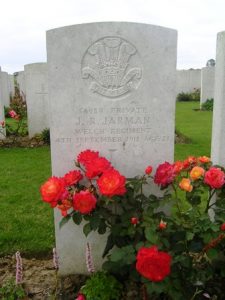
Arthur Edward Jones, Private, 10921, Kings Shropshire Light Infantry. Arthur was born at Llanarthney in 1890, the son of George and Jane Jones. George was the Gardener at Middleton Hall, and the family lived at Garden Cottage. By 1901 the family had moved to Newbridge-on-Wye, Radnorshire, and Arthur enlisted at Hereford into the 5th Battalion, King’s Shropshire Light Infantry, which was attached to 42 Brigade, 14th (Light) Division. The Division was to see its first action during the Action of Hooge, where the Division was the first to be attacked by the German use of flamethrowers. It then fought at the Second attack on Bellewaarde. In July 1916 the Division moved to the Somme, and fought at the Battle of Delville Wood, and then the Battle of Flers-Courcelette, taking part in the attack on Gueudecourt, before being relieved and moving into the rear areas behind Arras to rest. The Division then took over a section of the front line at Arras, and in March 1917 followed the German Retreat to the Hindenburg Line, witnessing the destruction wrought by the Germans during their retreat. By the end of April, the Division had taken over positions around Wancourt, on the Arras to Cambrai road and the 5th KSLI were hard at work, digging assembly trenches, in preparation for the forthcoming Battle of Arras, before taking over Niger Trench. At dawn on 3 May 1917 the Division launched its attack, initially making gains, before the Germans counter-attacked. Arthur was killed in action during the desperate fighting of 3 May 1917, aged 27. He has no known grave and is commemorated on the Arras Memorial, France. Arthur is also commemorated at Gorslas, Carmarthenshire.
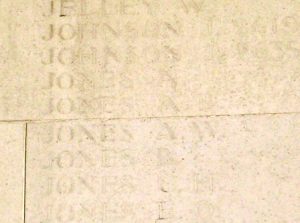
David Noel Jones, Private, 2009, Welsh Regiment. David was born at Abbeycwmhir in 1890, the son of John George Jones and Matilda Jones (nee Hamer). He resided at Pontarddulais prior to the war, where he worked as a tin-worker, and enlisted at Swansea into the 1/6th Battalion, Welsh Regiment. The battalion landed in France on 29 October 1914, and moved to work on Lines of Communication around Calais. On 5 July 1915 it became attached to 84 Brigade, 28th Division, and on 23 October 1915 transferred to 3 Brigade, 1st Division, which was at Loos. On 1 November 1915 the 6th Welsh left the front line at Auchel to carry out a scheme of divisional training at Burbere, in terrible weather. On 15 November the Division moved to the Mazingarbe sector, and the 6th Welsh took over some ‘very poor and dirty billets’ in the village. On 19 November the 6th Welsh moved back into the front line to begin a routine tour, and two days later were visited in the trenches by Tom Richards, MP and representatives of the Miner’s Federation. The 6th Welsh was relieved by the 2nd Welsh on 22 November 1915 and moved back into reserve, but David and another man of the battalion were killed by German snipers after the relief, whilst working on the support line. The 25-year-old is buried in Dud Corner Cemetery, Loos, France.
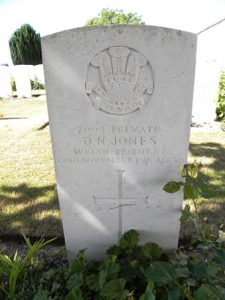
John Lister Dillwyn Venables-Llewelyn, Captain, Coldstream Guards. John was born on 20 March 1897, the son of Sir Charles Leyshon Dillwyn Venables-Llewelyn and Lady Katharine Dillwyn Venables-Llewelyn (nee Venables), of Penllergaer and of Llysdinam, Newbridge-on-Wye. His father was the CO of the Glamorgan Yeomanry, a Member of Parliament, and Lord Lieutenant of Radnorshire. John was commissioned from the Royal Military Academy, Sandhurst into the Coldstream Guards on 13 January 1915 and was posted to France on 19 October 1915, joining the 3rd Company, 3rd Battalion, Coldstream Guards. The battalion, attached to the 1st Guards Brigade, Guards Division, was rebuilding following heavy casualties at the Battle of Loos and the subsequent Action of the Hohenzollern Redoubt. The Division was holding the line near La Gorgue, and its battalion were carrying out the usual routine of trench rotation, four days in support, four days in the front and four days in reserve. During much of February and March 1916 the Division was out of the line training at Calais, then moved back into the line in the Ypres Salient for a short while. In July 1916 the Guards Division moved to the Somme, and fought at the Battle of Flers-Courcelette, and then at the Battle of Morval, capturing Lesboeufs Village. The CO of the 3rd Battalion, Sir John Vaughan Campbell, won the VC at the Somme. The Guards remained here for the winter, and in March 1917 took part in the advance caused by the German Retreat to the Hindenburg Line. In June 1917 the Guards moved north to Ypres, to prepare to take part in the opening assault of the Third Battle of Ypres, the Battle of the Pilckem Ridge, taking over the line to the left of the 38th (Welsh) Division, near Boesinghe. John was killed by shellfire during a routine spell in the trenches on 10 July 1917, three weeks before the start of the battle. The 20-year-old is buried in Canada Farm Cemetery, Ieper, Belgium. His younger brother, George, was killed in Norway in 1940.
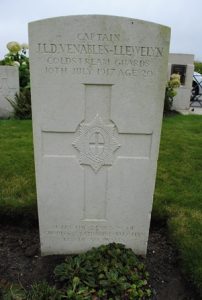
Albert Victor Mabbutt, MM, Private, 10917, King’s Shropshire Light Infantry. Albert was the son of Harry John Mabbutt and Eliza Mabbutt, of 10, Mawson Road, Cambridge. He worked as a Footman at Llysdinam Hall prior to the war. Albert enlisted at Hereford into the 5th Battalion, King’s Shropshire Light Infantry soon after the outbreak of war. The battalion had formed at Shrewsbury before joining 42 Brigade, 14th (Light) Division at Aldershot, and on 20 May 1915 landed at Boulogne. The Division moved to the Ypres Salient, and saw its first action during the Action of Hooge, where it became the first Division to be attacked by the German use of flamethrowers. The Division then fought at the Second attack on Bellewaarde. In July 1916 the Division moved to the Somme, and fought at the Battle of Delville Wood, and then the Battle of Flers-Courcelette, remaining on the Somme over the winter. During March 1917 the Division followed the German Retreat to the Hindenburg Line. May 1917 saw the Division at Arras, where it took part in the First Battle of the Scarpe, and later at the Third Battle of the Scarpe, before being were sent to Ypres, taking part in the Battle of Langemarck, where Albert was awarded the Military Medal for Bravery in the Field for his gallantry. The Division then took part in the First Battle of Passchendaele and the Second Battle of Passchendaele before moving south and taking over a section of front near St. Quentin where, in February 1918, the 5th KSLI was disbanded, and Albert was posted to the 7th KSLI, which was attached to 8 Brigade, 3rd Division, which was at Wancourt. On 21 March 1918 the Division was among those was hit hard by the German Spring Offensive, which was launched on the front running from Croisilles to La Fère, and saw heavy fighting as it withdrew over the coming days. Albert was killed during an artillery barrage near Henin on 27 March 1918, the day before the German infantry attacked again. He was 28-years-old and is buried in Wailly Orchard Cemetery, France.
Stanley Mason, Private, 8118, Herefordshire Regiment. Stanley was born at Cilfynydd, the son of George and Maria Mason. By 1895 the family had moved to Brickyard Cottage, Newbridge On Wye. Stanley worked as a railway platelayer for the Cambrian Railway prior to enlisting at Newbridge into the 1/1st Battalion, Herefordshire Regiment. The battalion was attached to the North Wales Brigade, Welsh Division at Bedford. On 13 May 1915 the formation became 158 Brigade, 53rd (Welsh) Division and on 16 July 1915 embarked at Devonport for Gallipoli. Stanley landed at Suvla Bay with the battalion on 9 August 1915. The division began to advance into the bush, but the situation was made difficult due to poor maps and no knowledge of the terrain and the advancing troops came under fire from the Turkish defenders. Stanley was wounded at sometime soon after the landings and was evacuated by Hospital Ship to Mudros Island where he died of his wounds on 18 August 1915, aged 23. He is buried in East Mudros Military Cemetery, Greece. Stanley is also commemorated on the Cambrian Railways memorial at Oswestry and on the Llanyre war memorial.
James Meredith, Private, 55068, Royal Welsh Fusiliers. James was the son of Thomas and Anne Meredith, of Bwlch y Draith, Newbridge-on-Wye. He married Edith Eleanor Davies in 1913 and the couple had two children. James worked on his father’s farm prior to enlisting at Llandrindod Wells into the army and was posted to the Monmouthshire Regiment. Once he had completed his training, he was posted in France in 1916, where he was transferred to the 10th Battalion, Royal Welsh Fusiliers. The battalion was on the Somme attached to 76 Brigade, 3rd Division and took part in heavy fighting in Delville Wood throughout July. After a brief rest the division moved back into the Somme front at Serre and took part in the Battle of the Ancre later in the year. During February 1917 the division moved slightly north to the Arras sector to begin a routine tour in the trenches. James was killed in action at Arras on 28 February 1917, aged 34. The 10th RWF was relieved later that day, marching back to billets in Arras. James has no known grave and is commemorated on the Arras Memorial, France. He is also commemorated on the Llanyre war memorial.
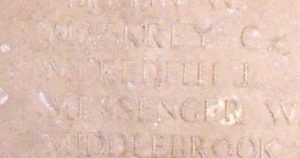
William Morris, Sergeant, 5424, Welsh Regiment. William was the son of Edward and Mary Morris, of Cascob. He was a long serving soldier, having enlisted into the Welsh Regiment at Swansea on 30 November 1897, and spent several years in South Africa with the regiment. He was serving with the 2nd Battalion, Welsh Regiment in Pembroke Dock by 1911, and at the outbreak of war was still at Pembroke Dock, with the 3rd Welsh. William remained on home service, probably training recruits, for the next two years, before being discharged as medically unfit on 16 September 1916, and returned to Newbridge-on-Wye, where he became a coal agent. He married Frances Laura Eleanor Morgan at All Saints Church on 19 June 1918, and the couple lived at Cross Road Cottage, Newbridge-on-Wye. William died at Newbridge-on-Wye on 2 December 1919, aged 40. He was buried in St. Llyr’s Churchyard, Llanyre on 5 December. William is not commemorated by the CWGC.
David Rees Powell, Private, 29212, South Wales Borderers. David was the son of David and Miriam Powell, of Llanerchllwyd, Llanafan Fawr. He enlisted into the South Wales Borderers early in 1915, and after completing his training was posted to France at some time in 1916, joining the 6th Battalion, South Wales Borderers, which was attached to the 25th Division, as the Divisional Pioneers. He probably joined the battalion early in 1917, following its losses during the Battle of the Somme, where the Division had taken part in several major actions. The Division moved to the Ploegsteert Sector, with the 6th SWB taking over a camp at Oosthove Farm, by the beginning of November 1916, and spent the coming months there, supplying working parties and constructing and improving trenches. At the end of February 1917, the 6th SWB moved to the Caestre area to carry out a training program and on 23 March moved to Neuve Eglise. The Division then took part in the Battle of Messines Ridge in June 1917, and remained in this area while the main Passchendaele offensive began on 31 July. David was killed whilst at work near Belgian Chateau on 9 August 1917, aged 23. He is buried in Belgian Battery Corner Cemetery, Ieper, Belgium.
Moses Oscar Powis, Driver, 219979, Royal Field Artillery. Moses was born in Newbridge-on-Wye in 1896, the son of Moses Powis and Sarah Jane Powis (nee Greenhouse). By 1911 the family was residing at 3, Windsor Street, Treherbert. Moses enlisted at Cardiff into the Royal Field Artillery, and was posted to the 404th Battery, Royal Field Artillery, which was in Mesopotamia, attached to the 17th Indian Division. Moses probably embarked for Mesopotamia in 1916 to join the battery, and would have taken part in several actions against the Turkish Forces occupying the country. He became ill, and died of inflammation in Baghdad on 27 June 1918, aged 21. Moses is buried in Baghdad (North Gate) War Cemetery, Iraq. Moses is not commemorated on the Newbridge-on-Wye war memorial.
Bert Price, Private, 9204, Royal Welsh Fusiliers. Bert was born in 1888, the son of David Gough Price and Helena Price (nee Weale), of Newbridge-on-Wye. The family had moved to Penydarren, Merthyr Tydfil after the turn of the century and Bert enlisted into the Welsh Regiment at Merthyr on 10 May 1906. He transferred to the Royal Welsh Fusiliers at some time afterwards and by 1911 was in India, serving with the 2nd Battalion, Royal Welsh Fusiliers, which was under the command of Major Henry Delmé-Radcliffe. At the outbreak of war, the 2nd RWF was at Portland, and landed at Rouen on 11 August, to work on Lines of Communication. After eleven days the battalion joined the 19th Brigade, at Valenciennes, west of Mons, and took part in the famous retreat from Mons to the Marne. The Brigade then took part in the ensuing Battle of the Aisne before moving to Flanders with the BEF, joining the 6th Division. The Division moved to the La Boutillerie sector, and took part in the famous Christmas Truce. January saw the Division at Bois Grenier, where on 31 May 1915, 19 Brigade transferred to the 27th Division in the same sector. On 19 August the Brigade transferred again, joining the 2nd Division in the Cuinchy Sector, then on 25 November joined the newly arrived 33rd Division, remaining in the Cuinchy Sector over the coming months, where the infantry battalions carried out the usual routine of trench rotation. On 22 June 1916 the 2nd RWF was holding a section of front line at Givenchy Left, when at 02.50 the Germans blew a massive underground mine beneath positions held by B Company, destroying 80 yards of line. The German artillery then bombarded the front line before launching a massive trench raid, with a force of 150 men. The surviving members of B Company managed to drive the Germans out, but had suffered severe casualties during the morning, with over 60 men killed, many of them missing, trapped under the debris. Bert was among those killed during the mine explosion that day. The remains of the 28-year-old were recovered after the war and he was reburied in Cabaret-Rouge British Cemetery, Souchez, France. The burial return states that his body was found in a dugout with three other men, and that they had all been buried alive. They were exhumed in February 1924 from the edge of what was later called Red Dragon Crater. Bert is not commemorated on the Newbridge-on-Wye war memorial.
George Henry Price, Private, 117783, Machine Gun Corps. George was the son of William and Rosina Price, of 33, Old Street, Ludlow, Salop. He lived in Newbridge-on-Wye prior to the war, and worked as a farm labourer. George enlisted at Knighton into the army and upon completing his training, was posted to Grantham, joining the newly formed 237th Company, Machine Gun Corps. The Company embarked for France, joining the 21st Division at Moyenville on 17 July 1917, and took over positions in the front line. During September 1917 the Division moved to the Ypres Salient, and took part in the Passchendaele offensive before moving south to the Arras Sector, taking over positions at Villers Faucon, facing the Hindenburg Line. On 24 February 1918 the 237th Company was merged into the 21st Battalion, MGC in the same Division and took over positions near Épehy. At dawn on 21 March 1918 the Germans launched a large-scale offensive, along the line running from Croisilles, just north of the 21st Division, down to La Fère, and the 21st Division was caught up in desperate fighting. George was killed that day, during fighting at Vaucelette Farm. The 22-year-old has no known grave and is commemorated on the Pozieres Memorial, France. He is not commemorated on the Newbridge-on-Wye war memorial.
Thomas Geoffrey Rawstorne, Major, Lancashire Hussars Yeomanry. Thomas was born in Hanover Square, London in 1880, the son of Lawrence Rawstorne, JP, a major land owner in Lancashire and Edith Elizabeth Rawstorne (nee Hesketh), of Rufford Hall. As well as their house in London, the family also owned Hutton Hall. Thomas married Margery Wyndham Portal on 24 July 1907. He worked as an Agent for Colonel Venables-Llewelyn at Llysdinam, Newbridge-on-Wye, and the couple lived on the estate, at Dolwen. Thomas also served as an officer with the Lancashire Hussars Yeomanry, and following the outbreak of war was promoted to Captain, in the 1/1st Battalion, Lancashire Hussars. The battalion was a Territorial unit, attached to the Welsh Border Mounted Brigade, but following the outbreak of war transferred to the West Lancs Division, moving to Kent. In October 1915 the unit was split up as divisional cavalry, so Thomas, now a Major, transferred to one of the units in the 38th (Welsh) Division. He was wounded in July 1916, possibly during the assault on Mametz Wood, and returned home on leave before embarking for France again in June 1917, re-joining the Division on the Canal Bank at Boesinghe. On 31 July 1917 the Division launched its assault on the Pilckem Ridge, as part of the opening phase of the Third Battle of Ypres, or Passchendaele. Thomas was seriously wounded during the opening assault that morning and died of his wounds that same day, 31 July 1917, aged 38. He is buried in Bard Cottage Cemetery, Belgium.
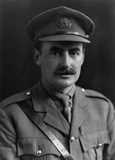
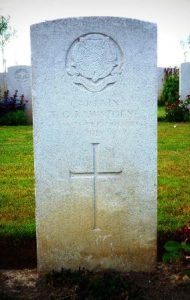
Charles Severs, Private, 772082, Canadian Infantry. Charles was born at York on 28 April 1884, the son of John and Mary Severs. He emigrated to Canada in 1911, and whilst there married Emily Katherine Williams, a domestic servant from Llysdinam, who had emigrated at around the same time, and the couple set up home at 196, Sheridan Street, Brantford, Ontario, where Charles worked as a Carpenter. He enlisted at Brantford into the 125th Battalion, Canadian Infantry on 18 November 1915 and sailed for England on 6 August 1916. Emily must have sailed back at around the same time, as she was by then living in 4, North Cottages, Llysdinam, Newbridge-on-Wye. Charles would have joined the Canadian Depot on Salisbury Plain, and on 10 October 1916 embarked for France, joining the 1st Battalion, Canadian Infantry, which was attached to the 1st Canadian Brigade, 1st Canadian Division, and was on the Somme, taking part in heavy fighting near Courcelette. The Division wintered behind the lines at Diéval, before taking over positions in the Arras Sector, holding the line at Souchez, facing Vimy Ridge. Charles was badly wounded during a routine spell in the trenches here, suffering a gunshot wound to his head, and was brought to St. John’s Ambulance Hospital, at Étaples for treatment. He died of his wounds there two days after arriving, on 29 March 1917, aged 33. Charles is buried in Étaples Military Cemetery, France. He is not commemorated on the Newbridge-on-Wye war memorial.
Francis John Thompson, Private, 31574, Welsh Regiment. Francis was the son of William and Ruth Thompson, of Lluestwen, Newbridge-on-Wye. He worked as a Carpenter prior to the war. Francis married Ada Jones, of Newbridge-on-Wye in 1915, just after having enlisted into the 19th Battalion, Welsh Regiment at Llandrindod Wells. The battalion trained at Colwyn Bay attached to the 38th (Welsh) Division, and was the Divisional Pioneer Battalion, formed of men with trades necessary to carry out important Pioneer work for the parent division, such as the construction of bunkers, digging trenches and dug-outs etc. The Division moved to Winchester in the summer of 1916, to complete its training and was inspected by King George V before embarking for France from 2 December 1915. The Division then moved to the Nursery Sector near Fleurbaix for trench initiation alongside the Guards Division. The Division then held a sector of the line near Cuinchy before marching south to the Somme sector in June 1916 to take part in the assault on Mametz Wood. The first attack on the wood was launched on a two-battalion front on 7 July, but failed, and the Divisional Commander, Sir Ivor Philipps, was replaced before the Division attacked again on a two Brigade front on 10 July 1916. The 19th Welsh advanced behind the Divisional infantry, with orders to consolidate captured positions, while men were also allocated the task of carrying material, such as barbed wire, forwards into the wood to aid this work. Francis was killed in action in Mametz Wood on 11 July 1916, aged 24. He has no known grave and is commemorated on the Thiepval Memorial, France.
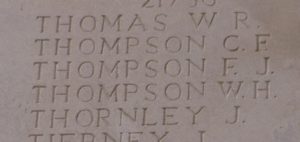
John Williams, Driver, 220511, Royal Field Artillery. John was the son of Robert and Ann Williams. His father worked for the Great Western Railway, and the family had lived in several places around Wales prior to becoming Station Master at Newbridge-on-Wye by 1911. John married Priscilla May Davies, of Cwm Defaid, Pantydwr, in 1916, after having enlisted at Knighton into the Royal Field Artillery. He was then posted to France, joining the Guards Division Ammunition Column. John probably saw his first action when the Guards Division moved to the Somme in the summer of 1916. After being moved from the Somme sector, the Guards Division enjoyed a relatively peaceful few months, until moving to the Ypres Salient to prepare for its assault on the Pilckem Ridge, as part of the opening of the Third Battle of Ypres, on 31 July 1917. John was accidentally killed at Ypres on 18 August 1917. The 24-year-old was buried in Canada Farm Cemetery, Belgium. The war memorial states that John served with the Welsh Regiment and that he fell in 1915, but nobody of that name with links to Newbridge-on-Wye matches the regiment or year.
Ernest Egerton Wright, Private, 51715, Cheshire Regiment. Ernest was the son of Jabez and Martha Wright, of Woodlands, Newbridge-on-Wye. He married Emily Davies on 18 November 1908, and the couple initially lived at Llangammarch Wells, before moving to the Toll Gate, Brecon Road, Builth Wells. Ernest enlisted into the King’s Shropshire Light Infantry at Brecon on 15 February 1916, and was posted to Shrewsbury. After completing his training, he embarked at Southampton on 19 October 1917, joining the 4th Infantry Base Depot at Rouen, initially destined for the 5th KSLI. On 25 October 1917 Ernest was instead transferred to the 15th Battalion, Cheshire Regiment, which was at Ypres attached to 105 Brigade, 35th Division. The Division had been involved in heavy fighting to the south of the Houthulst Forest and on 2 November the 15th Cheshire’s had moved to a rest camp near Proven. The Division then took over a section of the front line at Poelcapelle, where it remained over the winter. Unfortunately for the 35th Division, it was transferred south at the beginning of March 1918, reaching Suzanne, on the Somme, on 24 March, three days after the Germans had launched their great Spring offensive, and the Division was immediately sent forward to aid the troops in the front line at Maricourt. The battalion came into contact with the attacking German troops as soon as they arrived, and fierce fighting erupted. Ernest was killed in action that day, 24 March 1918, aged 33. He has no known grave and is commemorated on the Pozieres Memorial, France. Ernest is also commemorated on the Builth Wells war memorial.
World War Two, 1939-1945
Harold Alford, Sergeant, 1018130, Royal Air Force Volunteer Reserve. Harold was the son of Harold John Layton Alford and Helen Doris Alford, of the Cambrian Bakery, Newbridge-on-Wye. He married Winifred Mary Weale in 1941. Harold enlisted into the Royal Air Force Volunteer Reserve, and was posted to 221 Squadron, RAF, which was a maritime patrol unit, equipped with the Vickers Wellington, and moved to the Middle East in January 1942. The role of the Squadron was to locate enemy shipping, although it did carry out convoy escort duties as well. On 4 April 1943, Harold was aboard Wellington VIII, Serial HF910, on a routine patrol over the Mediterranean, when the aircraft lost power and crashed into the sea. Four crew members were rescued uninjured, but Harold and a passenger were missing. Harold was 23 years old when he died that day, and is commemorated on the Malta Memorial, Malta.
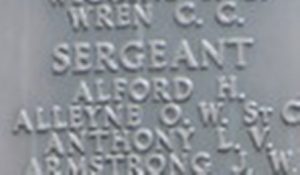
William Elwyn Davies, Leading Seaman, D/JX 147672, Royal Navy. William was born in Lampeter, Cardiganshire on 10 December 1919, the son of Gordon Davies and Mary Davies (nee Walters). The family moved to Rose Cottage, Newbridge-on-Wye soon after his birth, and after leaving school, William worked for a short while delivering coal. He enlisted into the Royal Navy prior to the war, and was posted aboard the Flower-class corvette, HMS Meadowsweet. She had been commissioned in July 1942, after having been built for convoy escort duties, and was put to work on the Atlantic Convoys. On 26 October 1942, Meadowsweet was in port at St. John’s, New Brunswick and many of her crew had been granted shore leave. William and a friend were walking along a road when they were knocked over by a car, and William was killed. William was 22 years old when he died that day, and is buried in Saint John (Fernhill) Cemetery, Saint John County, New Brunswick, Canada. His Uncle, Lieutenant David Walters, of Llanycrwys, Carmarthenshire, had been killed in the Great War.
Norah Ann Dehaan, Civilian. Norah was born on 15 April 1907, the daughter of Thomas and Lucy Lloyd, of Dderw, Newbridge-on-Wye. She had moved to London some years prior to the war, and married Abraham Alfred Dehaan in 1936. The couple lived at 103, Carlyle Road, London. Her husband had enlisted into the Royal Electrical and Mechanical Engineers after the outbreak of war. Norah was killed at her home at 103, Carlyle Road, during an air raid on 3 March 1943. The 36-year-old was buried in Manor Park Cemetery, East London. Norah is not commemorated on the Newbridge-on-Wye war memorial.
George William Dillwyn Venables-Llewelyn, MiD, Lieutenant, 87747, Royal Engineers. George was born on 20 August 1910, the son of Sir Charles Leyshon Dillwyn Venables-Llewelyn and Lady Katherine Minna Venables, of Penllergaer and Llysdinam, Newbridge-on-Wye. He was educated at Marlborough and after graduating, he became a Member of the Institute of Civil Engineers [MICE] and was an Assistant Engineer with Sir Alexander Gibb and Partners, consulting civil engineers. At the outbreak of the war, he was commissioned into the Royal Engineers, and initially served with the 53rd (Welsh) Division, before volunteering for the newly formed army commandos, and was posted to No.2 Independent Company, which had been raised from volunteers from the 53rd Division. The Company was sent to Norway on 27 April 1940, as part of Scissors Force, following the German invasion of Norway. The unit saw heavy fighting while the main British forces were withdrawn and evacuated from Norway, and George was killed in action during this chaotic period, during the Battle for Narvik on 26 May 1940. The 29-year-old was buried in Saltdal Main Churchyard, Norway. He was posthumously Mentioned in Despatches for his actions prior to his death. His eldest brother, John, had been killed in the Great War.
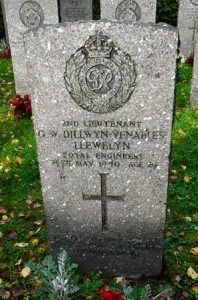
Frederick Thomas Pritchard, Aircraftman 2nd Class, 1654694, Royal Air Force Volunteer Reserve. Frederick was born in Shrewsbury on 13 November 1905, the son of David and Edith Mary Pritchard. He married Lilian May Powell Meredith, of Somerset House, Newbridge-on-Wye in 1937, and the couple moved to Colwyn Bay, where Frederick had gained a position as a Bank Clerk. Frederick enlisted into the Royal Air Force Volunteer Reserve following the outbreak of war, and was posted to 543 Squadron, RAF, which had been formed at RAF Benson on 19 October 1942, as a photo-reconnaissance unit, equipped with the Supermarine Spitfire. Frederick had only been with the Squadron for a month before he died at the Radcliffe Infirmary, Oxford on 20 November 1942, aged 37. His remains were brought home for burial in All Saints Churchyard, Newbridge-on-Wye. Frederick is not commemorated on the Newbridge-on-Wye war memorial.
